
CULTURAL RESOURCES PROGRAM
Along Camp Pendleton’s Vandegrift Boulevard stands one of California’s many historic El Camino Real bells that has been around long before any Marine or sailor occupied the land. The bell symbolizes the trail used by the Franciscan Padres on the journey to Northern California from Mexico in the 1800s. The Padres were Catholic priests sent by the King of Spain to convert Native Americans of California to Catholicism, in order to become citizens of Spain. The bell on base stands where the trail crosses Vandegrift Boulevard, just inland of the main gate.
Marine Corps Base Camp Pendleton is an approximately 125,000-acre amphibious training center located along the Pacific coast in northern San Diego County. The base is one of the Department of Defense's busiest installations and offers a broad spectrum of training facilities for many active and reserve Marine, Army and Navy units, as well as national, state, and local agencies.
Despite being surrounded by a largely urbanized area, MCB Camp Pendleton has emerged as an important reservoir of archaeological and historical resources, with several hundred cultural resource sites recorded in a wide variety of settings within its boundaries. MCB Camp Pendleton also provides a unique natural landscape, that is home to several rare plant species and native landscapes that are now difficult to find elsewhere.
This website was created to provide information about important heritage assets located on base and to promote community involvement in cultural resource preservation and interpretation opportunities.
The mission of the cultural resource program is to support the MCB Camp Pendleton mission, achieve regulatory compliance, and ensure that stewardship responsibilities are met. The cultural resource program on MCB Camp Pendleton is conducted in accordance with a substantial number of federal laws, executive orders, regulations, standards, and guidelines, including the National Environmental Policy Act, Executive Order 11593 (Protection and Enhancement of the Cultural Environment), and the National Historic Preservation Act, among others. A list of applicable federal guidance on cultural resource management and preservation can be found here.
Cultural resources can be buildings, structures, districts, archaeological sites, historic landscapes, traditional cultural properties, Native American sacred sites, and objects of significance in history, architecture, archaeology, engineering, or culture that are eligible for or included in the National Register of Historic Places. Cultural resources can also include associated documents and records.
Stewardship responsibilities include the identification of cultural resources, evaluation of cultural resources for eligibility for listing on the National Register of Historic Places, the evaluation and assessment of effects to cultural resources resulting for various undertakings, the encouragement of cultural resource preservation, and the documentation of cultural resources if they are altered or destroyed. Other responsibilities held by the cultural resources program include communicating with various stakeholders to advance awareness and preservation of cultural resources.
Prehistory
Before the arrival of the Spanish explorers, and long before the establishment of Camp Pendleton, the area was home to thousands of Native Americans who used many of the same resources still present today, including the plants and animals found in the hills and along the Pacific coast.
Evidence from around the region suggests that humans arrived in current-day southern California approximately 13,000 years before present (B.P. [about 11,050 B.C.]). By 8,000 B.P., the coastal and lagoon habitats in the area likely supported a significant coastal population. Archaeological digs of sites dated to this time have uncovered abundant shellfish and fish remains, along with flaked cobble tools, basin metates, manos, discoidals , stone balls, and burials. Some evidence suggests that these people travelled into inland San Diego County on a seasonal basis.
By 3,800 B.P., research suggests that Native Americans had formed increasingly organized villages and specialized resource collection sites in a variety of interior and upland locations. Coastal settings continued to be used as well, but there is some debate as to the stability of some coastal habitations at this time. A number of technological changes took place during this time, most prominently the introduction of the bow and arrow and the widespread use of ceramics.
When first contacted by Spanish explorers, the native groups living at what is now Camp Pendleton spoke a language related to those dialects spoken by people closer to current-day Los Angeles than the language of people spoken in the current-San Diego area to the south. These groups were later known generally as the Juaneño and Luiseño, based on their associations with either Mission San Juan Capistrano or Mission San Luis Rey de Francia, respectively.
The region occupied by the Luiseño and Juaneño extended along the coast roughly between Agua Hedionda to approximately Aliso Creek in present Orange County, and inland approximately to Palomar Mountain. To the north were the linguistically related Gabrielino, who occupied the Los Angeles Basin, and to the south were the Yuman-speaking Kumeyaay. Sources indicate that Luiseño and Juaneño territorial units were fairly small, on the order of 30 square miles. The territorial division between them, such that it existed, is thought to have been somewhere between San Mateo Creek and Las Pulgas Creek.
History
Europeans first entered the area that is now Camp Pendleton on July 20, 1769, as the members of the Portola expedition descended into the valley of the Santa Margarita River during their journey north to Monterey. The earliest permanent structures on MCB Camp Pendleton are described in an 1827 mission report as a small adobe at what is now the Santa Margarita Ranch House, and a mission estancia at Las Flores. The original Mexican owners of the land that was to become MCB Camp Pendleton were Pio and Andres Pico, who acquired the Rancho San Onofre and Rancho Santa Margarita in 1841.
In 1849, Pio Pico moved to the Los Coyotes Rancho in Los Angeles, leaving the Santa Margarita ranch in the control of his brother Andres. Andres left later that year for the gold fields, however, and the rancho was managed in turn by Pio’s elder brother Jose Antonio. By 1862, the Pico family had fallen into financial difficulties and sold part of the rancho to their brother-in-law, Juan Forster, to avoid losing it to creditors. Forster, after undertaking a number of improvements, died in 1882 and the ranch eventually was transferred to James C. Flood and Richard O’Neill. During this time, the ranch was managed by O’Neill, with assistance from the Magee family who lived at the Las Flores adobe from 1888 to 1968. In 1901, O’Neill was awarded one-half of the ranch by Flood’s heirs, holding the property until it was acquired by the U.S. Marine Corps in 1942.
Since its establishment in 1942, major development at MCB Camp Pendleton has supported its mission as an amphibious training facility. Military development on the installation during World War II involved the development of support facilities for the construction efforts. Placed mainly in the “Mainside” area, these included warehouses, a lumberyard, a mill, a steelyard, a quarry, and barracks for workers. Major military facilities constructed at this time included a rifle qualification range, tent camps at the Mainside area, and construction of a boat basin. Major military operations included the arrival of the 9th, 4th, and 5th Marines, all quartered at Mainside. After World War II, Major General Graves B. Erkstine initiated a number of developments designed to create a more permanent facility at MCB Camp Pendleton. Primary examples include the construction of the beach club at San Onofre, a commissary, a golf course, a library, and the base rodeo grounds.
A major build-up of personnel and facilities took place during the Korean War. For example, the first permanent barracks with mess hall and administration building was constructed in the 22 Area (Chappo), and field training camps were established at the 62 Area (San Mateo), 43 Area (Las Pulgas), 53 Area (Horno), and 33 Area (Margarita). Due to legal disputes over water rights along the Santa Margarita River, relatively limited funding was available for construction on MCB Camp Pendleton during the post-Korean War years. Significant construction took place in 1961, however, with the construction of eight permanent Bachelor’s Enlisted Quarters (BEQs), two mess halls, a training school, two administration buildings, and 400 units of Capehart housing within and near the 21 Area (Del Mar). Development of the Edson rifle range and support facilities was also conducted at this time.
A variety of facilities was constructed during the Vietnam conflict. Training schools for jungle warfare were established near the 43 Area (Las Pulgas), 53 Area (Horno), and 27 Area (Naval Hospital). A new Combat Town in the 52 Area (School of Infantry) was also built. Other facilities constructed at this time included an exchange complex in the 11 Area, regimental headquarters at the 62 Area (San Mateo) and 53 Area (Horno), Bachelor Officer’s Quarters housing in the 17 Area (Headquarters) near the San Luis Rey gate, a new brig, new housing at the 51 Area (San Onofre) and 20 Area, and the 31B Area (Marine Corps Tactical Systems Support Facility) at Stuart Mesa.
Native American Consultation and Outreach
Camp Pendleton maintains an ongoing consultation program with both federally recognized and non-federally recognized Native American tribes affiliated with the land that is now known as Camp Pendleton. The Luiseño tribe consists of seven bands within Riverside and San Diego Counties. Six of these bands are federally recognized: Soboba Band of Luiseño Indians near San Jacinto, Pechanga Band of Luiseño Indians near Temecula, Pauma Band of Luiseño Indians in Pauma Valley, Rincon Band of Luiseño Indians near Valley Center, La Jolla Band of Luiseño Indians near Palomar, and Pala Band of Mission Indians in Pala. The San Luis Rey Band of Mission Indians is located in Oceanside and is not federally recognized. The Juaneño Band of Mission Indians – Acjachemen Nation are a non-federally recognized tribe with three groups that are in frequent communication with Camp Pendleton cultural resources program staff. These three Juaneño groups are located in southern Orange County, near the northern border of the base.
Tour Information and Requests
The Cultural Resource Section welcomes active and retired military, base residents, visitors, school groups, tribal organizations, cultural resources professionals and institutions, and members of the general public to visit the various heritage assets present on base.
Note: Only those with valid Department of Defense, other valid government agency identification or sponsored visitors will be allowed access to Camp Pendleton. For further base access information go to: http://www.pendleton.marines.mil/Base-Access/
To request tours of the Ranch House National Historic Site and the Marine Corps Mechanized Museum on Camp Pendleton, please email your requests to: MCBCAMPEN_history@usmc.mil or phone (760)725-5758.
Museum staff will work to provide your access to the base for Docent-led tours which are available by appointment. In addition, you will need current identification, proof of insurance, proof of registration. You may be searched at the gate.
Visit the Marine Corps Mechanized Museum on facebook or go to: http://www.themech.org/
The Camp Pendleton Historical Society is a 501(c)3 organization in support of the base's History and Museum's programs. Go to: http://www.camppendletonhistoricalsociety.org/ for information.
Brochures for Cultural Resource Sites on MCB Camp Pendleton and Tour Information
A number of heritage assets are present on MCB Camp Pendleton that can be visited by members of the public interested in the rich cultural heritage and history of the area. The Cultural Resource Section welcomes active and retired military, base residents, visitors, school groups, tribal organizations, cultural resources professionals and institutions, and members of the general public to visit the various cultural resource sites present on base. The information presented below provides details on how to visit these locations.
In some cases, informational brochures have been developed that present a detailed history of the heritage assets. When available, these brochures can be downloaded by following the links below.
Santa Margarita Ranch House and Prehistoric Village of Topomai
The complex is listed as the Santa Margarita Ranch House National Historic Site as well as a California State Historical Landmark. The complex includes the Ranch House Chapel, the oldest structure on base, the Bunkhouse Museum, dedicated in 1978 by Col James Roosevelt, and the Ranch House, built in the mid 1800s. This was the home of Pio Pico, last governor of Mexican California, and succeeding owners Don Juan Forster, the O'Neills, Floods, Baumgartners and, finally, United States Marine Corps Commanding Generals. Historic artifacts at the complex document pre-history through Mission and Rancho periods, the 1942 purchase of Camp Pendleton, and reflect the WWII and the Korean War. Exhibits include early ranch equipment, photographs of President Roosevelt's historic visit, antiques donated by Anthony Quinn during the filming of "Guadalcanal Diary" in 1943 and early Base history including SSgt Reckless and the Mounted Color Guard.
The prehistoric Luiseño village of Topomai is nearby. Archaeological studies suggest that the major Native American occupation of this location took place immediately prior to and during the early Spanish period. Like other Luiseño rancherias, Topomai would have been politically autonomous, controlling a certain well-defined territory surrounding the main village. Resources within Topomai’s territory would have been closely managed, and the territory boundaries vigorously defended. Pre-contact population estimates range from 10,000 to 3,000 persons, while population estimates during the Mission period are between 200 and 100 persons.
Tours are available by appointment and begin at 10 a.m. from the last week in September to the end of May. Tours can be requested via email by clicking here. Tours may also be requested by calling (760) 725-5758 or by faxing (760) 725-5727, “Attn: History and Museums.
Las Flores Estancia, Las Flores Adobe, and Prehistoric Village of Uchme
Located near the coast at the mouth of Las Flores Creek, the Las Flores Estancia was established in approximately 1827 and consisted of a large rectangular-shaped adobe building that included a chapel and hospice used to house travelers between the San Luis Rey and San Juan Capistrano Missions. After the secularization of missions by the Mexican government during the 1830s, the estancia became a Native American pueblo, and ultimately was absorbed into the Rancho Santa Margarita y Las Flores. By the late 1860s, the compound was used as a corral and stables until it was abandoned and fell into ruin. The Las Flores Adobe was built in 1868 and features three elements: the two-story Monterey Style building, a Hacienda Style building, and a carriage house. The property and its buildings have been listed in the National Register of Historic Places since 1991 and the Las Flores Adobe has been a National Historic Landmark since 1968. The prehistoric Luiseño village of Uchme is nearby. Ethnographic information suggests that the emergence of Uchme as a key village may have been the result of the consolidation of smaller villages in the region during the 1700s in favor of villages in key locations near reliable regional water supplies. The site was occupied throughout the Mission period and, by the end of the period, had become an independent pueblo for Luiseño associated with Mission San Luis Rey who had converted to Christianity. In 1838, there were 138 people residing at Uchme. A visitor to the village in the early 1800s noted grazing cattle and gardens, “scattered about in the little valleys, cultivated by Indians, for their own personal benefit, and in which they are permitted to labor when not required to give their time to the interests of the Mission.”
Tours are available of Las Flores the second Friday of every month. Tours can also be arranged by appointment provided advanced noticed of 15-30 days prior to the day of the planned visit. Tours can be requested via email by clicking here.
Los Cristianitos Archaeological Site
The archaeological site known as Los Cristianitos is the reputed location of the first baptism in Alta California. This act was described to have been performed by two priests from the Portola expedition on two dying Native American infants. A path and steps lead down from the terrace to a spring that is at the base of the slope and is roughly 20 meters from the top of the terrace. The site is a California State Historical Landmark.
Patrons are able to visit the Los Cristianitos Archaeological Site at any time.
A Ribbon of Concrete - the Story of Old State Route 2 on MCB Camp Pendleton
This 7 mile long section of two-lane concrete road, located on Marine Corps Base Camp Pendleton, is one of the few remaining sections of California's first paved highway-Old State Route 2. Today it is dwarfed by Interstate 5, but in its day, State Route 2 was cutting edge technology. In 1926 California Highways magazine even called it "a monument to its builders, both engineers and contractors." When it was finished, State Route 2 followed California's coastline from San Diego to San Francisco, often along the same route as the historic El Camino Real. It was the first state highway to connect these major cities.
Get brochure here
Camp Talega
Camp Talega, officially known as Area 64, is located at the very northern end of MCB Camp Pendleton where Cristianitos Road and Talega Ridge Road intersect. Camp Talega consists of several long rows of approximately 70 Quonset huts, miscellaneous support structures, and two medieval-style towers located at its entrance. The area was developed during World War II as a training camp, with the majority of buildings built between 1944 and 1954. In 1975, Camp Talega and its surrounding area was used as a temporary camp for thousands of Vietnamese refugees as part of a massive resettlement program following the end of the Vietnam War.
A self-guided tour of Camp Talega is available for all patrons. Please check-in and pick up the self-guide booklet at Building 64385.
Camp Pendleton Driving Tour
A driving tour that directs authorized patrons to a number of historic sites on Camp Pendleton is also available. The driving tour provides directions to historic sites and interpretive information. The suggested route begins at a segment of El Camino Real and ends at the San Onofre Beach Club.
Get Brochure Here
Final documents related to cultural resources activities on base are included here. Due to the sensitive nature of some information, it is not uncommon for these final documents to be redacted in some areas. These documents can be viewed online, downloaded to your computer, or viewed in hardcopy at the Cultural Resources Section located in Building 2648 or at the complete Administrative Record at Naval Facilities Engineering Command Southwest (NAVFACSW) in San Diego, California.
Environmental Assessments and Environmental Impact Statements for projects on MCB Camp Pendleton can be found by clicking here
Integrated Cultural Resource Management Plan
MCB Camp Pendleton has updated its Integrated Cultural Resource Management Plan (ICRMP). The 2017 ICRMP Update presents the overall cultural resource management strategy for MCB Camp Pendleton, as well as standard operating procedures and various references related to the history of the base and cultural resource management legislation.
To download a copy of the ICRMP, please click here
Email: M_PNDL_ENV-Cultural-Resources-Section@usmc.mil
Cultural Resources Public Outreach and Interpretation Plan
This document is part of the larger ICRMP update and provides recommendations for outreach and interpretation regarding cultural resources.. The document’s aim is to outline an effective public outreach and interpretation program that fosters an appreciation for the past by increasing the understanding of the rich history of MCB Camp Pendleton and those who have used the land in the past, and by developing an awareness of the unique resources that are associated with it.
Available soon.
Camp Pendleton Section 106 Programmatic Agreement
The MCB Camp Pendleton Section 106 Programmatic Agreement establishes the processes by which installation personnel are to operate in accordance with the National Historic Preservation Act’s intent and regulations, including the requirement to integrate cultural resources planning and management decisions in the installation’s policies and other program requirements. The Programmatic Agreement also streamlines the Section 106 process of the National Historic Preservation Act and eliminates case-by-case consultation with the State Historic Preservation Officer and Invited Signatories in certain instances.
To download a copy of the Section 106 Programmatic Agreement, please click here
The following terms are commonly used when discussing archaeological resources and heritage assets on Camp Pendleton. Definitions have been provided by the Archaeological Institute of America (AIA). The AIA has an expanded glossary of terms which can found here .
A.D. - Abbreviation for the term Anno Domini Nostri Jesu Christi (or simply Anno Domini) which means, "in the year of our Lord Jesus Christ." Years are counted from the traditionally recognized year of the birth of Jesus. In academic, historical, and archaeological circles, A.D. is generally replaced by the term Common Era (C.E.)."
Anthropology - The study of human beings, including their behavior, biology, linguistics, and social and cultural variations. In the United States, anthropology is divided into four sub-disciplines: archaeology, biological/physical anthropology, cultural anthropology, and linguistics. All the sub-disciplines study aspects of past or present humans. Archaeologists generally study the physical and material remains of ancient societies, while cultural anthropologists study living cultures. Physical anthropologists study human skeletons and other bodily remains. Biological anthropologists deal primarily with the evolution of humans and primates. Linguists study languages, especially their development and their function within human culture.
Archaeology - The scientific excavation and study of ancient human material remains.
Archaeological site - A place where evidence of past activity is present and preserved.
Artifact - A portable object manufactured, modified, or used by humans.
Assemblage - A group of artifacts found within the same archaeological context (locus, matrix, stratum).
Association - Objects found near one another in the same context are said to be in association.
B.C. - Abbreviation for the term “Before Christ.” Years are counted back from the traditionally recognized year of Christ's birth. In academic, historical, and archaeological circles, this term is now generally replaced by Before Common Era (B.C.E.).
B.P. - Before Present; used in age determination instead of B.C. or B.C.E. "Present" is academically defined as the year 1950 (the year when this term was invented).
Biface tools - Stone tools that have been worked on both sides or faces, meaning that flakes have been intentionally (not naturally) chipped off from both sides of the stone.
Cache (pronounced "cash") - A collection of objects that was purposefully buried.
Chert - A fine-grained sedimentary rock, similar to flint, that is white, pinkish, brown, gray, or blue-gray in color. In antiquity, chert was one of the universally preferred materials for making stone tools (obsidian was another).
Chipped stone tool - Stone tool made by striking a stone (core or preform) with another stone (hammerstone) or other hard material (such as antler). Small pieces of stone (flakes) were struck off the core in a controlled and precise manner to create a usable shape (arrow heads, spear points, knives, etc.). The two main techniques of creating chipped tools were direct percussion (the core is struck directly with a hammerstone) and indirect percussion (another object is placed between the core and the hammerstone).
Conchoidal - Relating to stone tools, the term conchoidal describes a specific type of fracture created when obsidian, chert, or glass-like substances are struck with a hard instrument and a flake is removed. The fracture pattern produces a flake that appears bent.
Core - A chunk of stone from which flakes are removed. The core itself can be shaped into a tool or used as a source of flakes to be formed into tools.
Cultural resource - The physical evidence of past human activity. This evidence can include buildings, structures, districts, archaeological sites, historic landscapes, traditional cultural properties, Native American sacred sites, and objects of significance in history, architecture, archaeology, engineering, or culture that are eligible for or included in the National Register of Historic Places. Cultural resources can also include associated documents and records.
Cultural resource manager - A professional with the responsibility of documenting, preserving, interpreting, and evaluating various cultural resources. Cultural resource managers typically have an educational background in anthropology and archaeology.
Debitage - Small pieces of stone debris that break off during the manufacturing of stone tools. These are usually considered waste and are a by-product of production.
Diffusion - The transmission of ideas or materials from culture to culture, or from one area to another.
District - A concentration of sites, buildings, structures, or objects that are united historically or aesthetically by plan or physical development.
Ethnography - A branch of anthropology that studies and describes modern human cultures (rather than human behavior or physical attributes). Archaeologists sometimes work with ethnographers in an effort to correlate behavior with material remains.
Feature - Any physical structure or element, such as a wall, post hole, pit, or floor, that is made or altered by humans but (unlike an artifact) is not portable and cannot be removed from a site.
Flake - A piece of stone removed from a core for use as a tool or as debitage.
Geoarchaeology - Archaeological research using the methods and concepts of the earth sciences. Geoarchaeologists often study soil and sediment patterns and processes of earth formation observed at archaeological sites. This form of research provides a wealth of information about context and human activity.
Grave goods - Objects placed within human burials to equip a person for the afterlife or to identify the deceased.
Heritage asset - A cultural resource that is considered to have substantial value because of its contribution to a group’s culture and/or knowledge. These assets are typically physical, but some countries also identify assets that are intangible or spiritual in significance.
Historic property - A specific term defined by the National Historic Preservation Act as “any prehistoric or historic district, site, building, structure, or object included in, or eligible for inclusion on the National Register.” These properties can also include artifacts, records, and remains which are related to districts, sites, buildings, structures, or objects.
Historical Archaeology - A discipline within archaeology concerned with supplementing written history with archaeological research to create a more complete account of the past. The term applies only to the study of societies with written records.
Hunter-gatherers - A community or group that subsists primarily by hunting wild game and gathering wild plant resources. Hunter-gatherers usually live in small groups of less the 150 individuals.
In situ - Anything in its natural or original position or place is said to be in situ.
Knapping - A technique for making stone tools and weapons by striking flakes from a core with a hard (stone) or soft (antler) percussion instrument. Individual flakes or cores can be further modified to create tools. Also called flintknapping.
Law of Superposition - A physical "law" asserting that deeper layers of sediment or archaeological strata will naturally be older than the layers above them (in the absence of unusual, disruptive, activity, such as earthquakes).
Lithic - Of or pertaining to stone.
Locus - A specific point in space; a discrete excavated unit or archaeological context (plural = loci).
Matrix - The physical material (often dirt) in which archaeological objects are located.
Microlith - Small, flaked stone tools, 1-4 cms in length.
Midden - A deposit of occupation debris, rubbish, or other by-products of human activity, such as shell, bone, or debitage, found close to a living area; a trash heap or pit.
National Register of Historic Places - The United States’ list of districts, sites, buildings, structures, and objects officially deemed worthy of preservation. The National Register is part of a larger national program to coordinate and support public and private efforts to identify, evaluate, and protect historic and archaeological resources.
Palynology - The recovery and study of ancient pollen grains for the purposes of analyzing ancient climate, vegetation, and diet.
Pedology - The scientific study of soils.
Petroglyph - A carving on a rock surface.
Petrology - The geological and chemical study of rocks.
Pictograph - A drawing on a rock surface using paint or other means aside from carving.
Pressure flaking - Technique of removing flakes from a core by applying pressure steadily until the flake breaks off, in contrast to percussion flaking, in which the flake is struck off.
Primary context - The context of an artifact, feature, or site that has not been disturbed since its original deposition.
Provenance - The origin, or history of ownership of an archaeological or historical object.
Provenience - The three-dimensional context (including geographical location) of an archaeological find, giving information about its function and date.
Radiocarbon dating - An absolute dating technique used to determine the age of organic materials less than 50,000 years old. Age is determined by examining the loss of the unstable carbon-14 isotope, which is absorbed by all living organisms during their lifespan.
Relative dating - A system of dating archaeological remains and strata in relation to each other. By using methods of typing or by assigning a sequence based on the Law of Superposition, archaeologists organize layers or objects in order from "oldest" to "most recent." Relative dating methods help archaeologists establish chronologies of finds and types.
Secondary Context - Context of an artifact that has been wholly or partially altered by transformation/site formation processes after its original deposit, as in disturbance by human activity after the artifacts' original deposition.
Section 106 of the National Historic Preservation Act - A portion of the National Historic Preservation Act that requires Federal agencies to take into account the effects of their undertakings on historic properties, and afford the Advisory Council on Historic Preservation an opportunity comment on the findings. Associated regulations published in the Code of Federal Regulations at 36 CFR 800 require agencies to consult with a range of stakeholders, including Native American tribes.
Settlement pattern - Distribution of human settlements on the landscape.
Shard - The term used for a piece of broken glass from an archaeological context.
Sherd - The term used for a piece of broken pottery from an archaeological context.
Site - Any place where human material remains are found; an area of human activity represented by material culture.
Stratigraphy - The study of the layers (strata) of sediments, soils, and material culture at an archaeological site (also used in geology for the study of geological layers).
Test unit - An excavation unit used in the initial investigation of a site or area, before large-scale excavation begins, that allows the archaeologist to "preview" what lies under the ground.
Thermoluminescence (TL) - A radiometric dating technique in which the amount of light energy released when heating a sample of pottery or sediment is measured as an indicator of the time since it was last heated to a critical temperature.
Traditional cultural property - A historic property that is eligible for inclusion in the National Register of Historic Places based on its associations with the cultural practices, traditions, beliefs, lifeways, arts, crafts, or social institutions of a living community.
Typology - The study and chronological arrangement of artifacts, such as ceramics or lithics, into different types based on associating similar characteristics. Typing makes a high volume of samples easier to study and compare.
Uniface tools - Tools or points that are worked or knapped on only one side or face.
Use-wear analysis - Microscopic analysis of artifacts or bones to find wear patterns or damage marks that indicate how the artifact was used.
The list below shows the dates and times for events and cultural resource-specific activities occurring on MCB Camp Pendleton.
No events planned at this time
In addition to these organized events, the Cultural Resource Section welcomes active and retired military, base residents, visitors, school groups, tribal organizations, cultural resources professionals and institutions, and members of the general public to visit the various heritage assets present on base.
Note: Only those with valid Department of Defense, other valid government agency identification or sponsored visitors will be allowed access to Camp Pendleton. For further base access information go to: http://www.pendleton.marines.mil/About/BaseInformation/BaseAccess.aspx
Historical Sites
|

Las Flores Estancia and Adobe
|
|
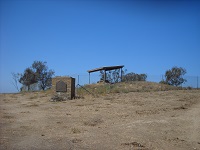
Estancia Ruins
|
|

Plaque at Las Flores Estancia and Adobe
|
|

Las Flores Adobe
|
|

Barn at Las Flores Estancia and Adobe
|
|

Interpretive Panels at Las Flores Estancia and Adobe
|
|

San Onofre Beach Club Building, West Main Entrance
|
|
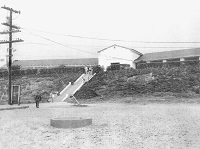
San Onofre Beach Club Building, Looking East from the Beachfront, 1964
|
|

Exterior of Church at Santa Margarita Ranch House
|
|

Interpretive Panel at Santa Margarita Ranch House Church
|
|

Internal Courtyard at Santa Margarita Ranch House
|
|

Study at Santa Margarita Ranch House Used by Jerome O’Neill
|
|
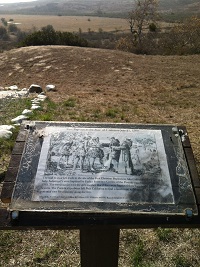
Interpretive Panel at Lost Cristianitos
|
|
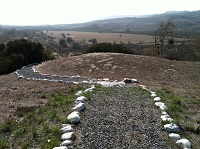
Path to Spring at Los Cristianitos
|
|

Spring and Plaque at Los Cristianitos
|
|

La Cristianita Plaque
|
|

1st Marine Division Headquarters Exterior
|
|
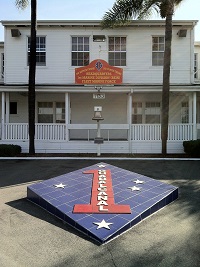
1st Marine Division Headquarters Front
|
|

Exterior Memorial at 1st Marine Division Headquarters
|
|

Interior Interpretive Displays at 1st Marine Division Headquarters
|
|
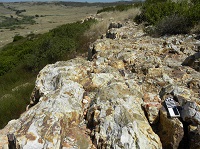
Main Outcrop at Piedra de Lumbre Quarry Site, Facing North
|
|

Camp Talega Quonset Huts
|
|

Entrance of Camp Talega
|
|
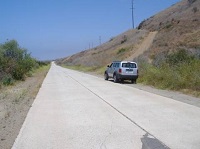
El Camino Real, Two-Lane Asphalt Road
|
|
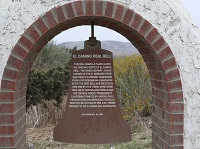
Modern Replica of 1900s Commemorative Bell
|
|
|
| |
|
|
|
Artifacts
|
|

Metate
|
|

Overview of Rock Outcrops at the Piedra de Lumbre Quarry Site
|
|

Projectile Point
|
|

Overview of Rock Outcrops at the Piedra de Lumbre Quarry Site
|
|

Shell Pendant
|
|

Bifacial Tools
|
|

Discoidals
|
|
|
The following internet links provide information on archaeology, regional history, Tribal events and activities, and other opportunities to get involved in cultural resource protection and stewardship.
Camp Pendleton Historical Society
http://www.camppendletonhistoricalsociety.org/
The Camp Pendleton Historical Society is dedicated to preserving and broadcasting the rich and colorful history of the land that is now Camp Pendleton. The Society’s interests span the entire history of the region, to include prehistoric times, native American culture, the Spanish mission era, the rancho story, and finally, Marine Corps ownership since 1942.
Society for California Archaeology
http://scahome.org/
The Society for California Archaeology is a nonprofit scientific and educational organization dedicated to research, understanding, interpretation and conservation of the heritage of California and the regions that surround and pertain to it. The Society promotes cooperation among archaeologists with an interest in California and seeks to increase public appreciate and support for archaeology in California.
San Diego County Archaeological Society
http://www.sandiegoarchaeologicalsociety.com/
The San Diego Archaeological Society is a non-profit scientific and educational organization focused on the study and preservation of the archaeological and anthropological heritage of San Diego County and contiguous areas. The Society encourages an interest in and an understanding of archaeology, anthropology and related subjects, as they pertain to California in general and to San Diego County in particular.
San Diego Archaeological Center
http://www.sandiegoarchaeology.org/
The San Diego Archaeological Center is a curation facility and museum where visitors can learn the story of how people have lived in San Diego County for the past 10,000 years. In addition to its role as a museum, the Center serves as an education and research facility and is the only local organization dedicated to the collection, study, curation and exhibition of San Diego County's archaeological artifacts.
California Preservation Foundation
http://www.californiapreservation.org/main.html
The California Preservation Foundation provides statewide leadership, advocacy and education to ensure the protection of California’s diverse cultural heritage and historic places. The Foundation seeks to influence behavior and practice by promoting the means and incentives to preserve historic properties for their economic value, their role in preserving community identity and as a tangible link to the past for current and future generations.
Fallbrook Historical Society
http://www.fallbrookhistoricalsociety.com/
The Fallbrook Historical Society was chartered in 1976 and is dedicated to collecting, preserving and displaying the history and artifacts of the Fallbrook area. The Society’s complex include a museum and a restored Victorian farmhouse with barn.
Oceanside Historical Society
http://oceansidehistoricalsociety.org/
The Oceanside Historical Society is focused on collecting, preserving, and presenting the history of the City of Oceanside. This includes information on early settlers, cemeteries, and Oceanside’s role in popular culture.
San Onofre Foundation
http://www.sanonofreparksfoundation.org/site/
The San Onofre Foundation (SOF) is a California non-profit, charitable corporation, whose mission is to provide education, protection, and preservation for the California State Parks at San Onofre and San Clemente State Beaches.
California Cultural Resources Preservation Alliance
http://www.ccrpa.com/
The California Cultural Resources Preservation Alliance is a non-profit charitable organization formed in 2003 that seeks to identify, preserve, and protect all cultural resources, and especially those located in California. The Alliance’s membership is formed by Native Americans, scientific communities, and preservation advocates working together for the preservation of archaeological sites and other cultural resources.
State Historic Preservation Office
http://ohp.parks.ca.gov/
The California State Office of Historic Preservation is responsible for administering federally and state mandated historic preservation programs to further the identification, evaluation, registration and protection of California's irreplaceable archaeological and historical resources under the direction of the State Historic Preservation Officer, a gubernatorial appointee, and the State Historical Resources Commission. The Office’s responsibilities include identifying, evaluating, and registering historic properties.
San Diego Natural History Museum
http://www.sdnhm.org/
The San Diego Natural History Museum’s mission is to interpret the natural world through research, education and exhibits; to promote understanding of the evolution and diversity of southern California and the peninsula of Baja California; and to inspire in all a respect for nature and the environment.
San Diego Museum of Man
http://www.museumofman.org/
The San Diego Museum of Man is focused on anthropology and its mission is to inspire human connections by exploring the human experience.
Native American Heritage Commission
http://www.nahc.ca.gov/
The Native American Heritage Commission aims to provide protection to Native American burials from vandalism and inadvertent destruction, provide a procedure for the notification of most likely descendants regarding the discovery of Native American human remains and associated grave goods, bring legal action to prevent severe and irreparable damage to sacred shrines, ceremonial sites, sanctified cemeteries and place of worship on public property, and maintain an inventory of sacred places.
La Jolla Band of Luiseno Indians
http://lajollaindians.com/
The La Jolla Band of Luiseno Indians is located near Palomar and is a Federally recognized tribal nation.
Pechanga Band of Luiseno Indians
http://www.pechanga-nsn.gov/
The Pechanga Band of Luiseno Indians is located in Temecula and is a Federally recognized tribal nation.
Pala Band of Mission Indians
http://www.palatribe.com/
The Pala Band of Mission Indians is located in Pala and is a Federally recognized tribal nation.
Pauma Band of Luiseno Indians
http://www.paumatribe.com/index.php
The Pauma Band of Luiseno Indians is located in Pauma Valley and is a Federally recognized tribal nation.
Rincon Band of Luiseno Indians
http://www.rincontribe.org/
The Rincon Band of Luiseno Indians is located in Valley Center and is a Federally recognized tribal nation.
Soboba Band of Luiseno Indians
http://www.soboba-nsn.gov/
The Soboba Band of Luiseno Indians is located in San Jacinto and is a Federally recognized tribal nation.
San Luis Rey Band of Mission Indians
http://www.slrmissionindians.org/
The San Luis Rey Band of Mission Indians is located in Oceanside. The tribe is not currently recognized by the United States Bureau of Indian Affairs.
Juaneno Band of Mission Indians Acjachemen Nation
http://www.juaneno.com/
The Juaneno Band of Mission Indians, Acjachemen Nation, is located in San Juan Capistrano. The tribe is not currently recognized by the United States Bureau of Indian Affairs.
California Indian Basketweavers Association
http://www.ciba.org/
The California Indian Basketweavers Association is a non-profit founded in 1992 with the goal of supporting weavers and addressing the problems of access to materials and to preserve, promote, and perpetuate California Indian basket weaving traditions while providing a healthy physical, social, spiritual, and economic environment for basketweavers
Cultural Resource Program Personnel
Marine Corps Base Camp Pendleton’s Cultural Resources Program is a section under the Resource Management Branch, Environmental Security, located in Building 2648. The Cultural Resources Section is headed by the base Cultural Resource Manager and staffed by professional archaeologists. For more information please contact:
Kelli S. Brasket, Cultural Resources Section Head
Supervisory Archaeologist
(760) 725-9738
PNDL_ENV-Cultural-Resources-Section@usmc.mil
Click here for tour information